Stonehenge landscape
The surrounding archaeology of Stonehenge including the Avenue, King Barrow Ridge, the Cursus, Durrington Walls, Woodhenge
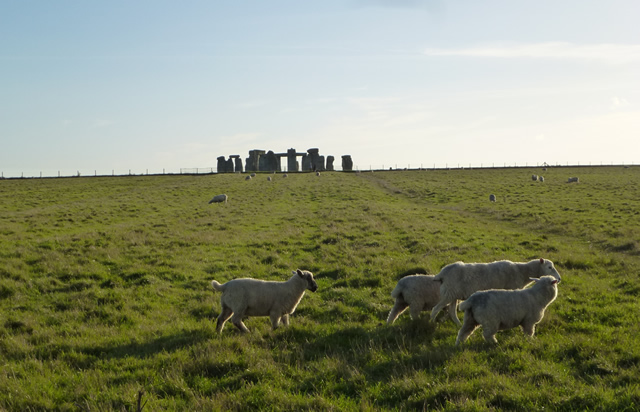
Stonehenge sits on Salisbury Plain, a flat area of chalk, covering some 300 square miles. The whole plain is an area rich in archaeology, Stonehenge being one of many ancient monuments or earthworks. The area that Stonehenge sits in has been classed the Stonehenge World Heritage Site and covers many square miles.
The landscape around Stonehenge is free to visit, owned by National Trust, offering some excellent walks with both natural and archaeological features of interest. One single walk can take in a number of prehistoric monuments, ancient burial mounds, and at Durrington walls, the outline of what was once a Neolithic village.
Stonehenge Cursus The Avenue King Barrow Ridge Normanton Down Barrows Winterbourne Stoke Barrows Robin Hood's Ball Woodhenge Cuckoo Stone Durrington Walls
Stonehenge wildlife
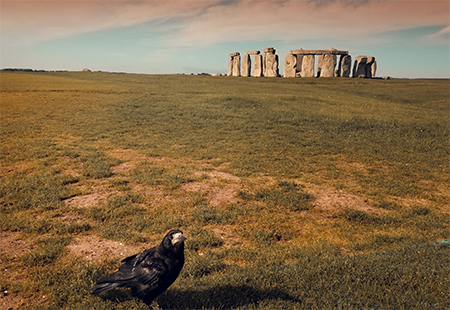
There is much wildlife to be enjoyed in the Stonehenge landscape at various times of year, from ancient woodlands on the King Barrow Ridge to grassland wild-flowers and murmurations of starlings to their roost sites.
The sites support many species of butterfly, which can be seen in the summer, in spring you might catch a glimpse of a hare and in autumn deer, in amongst the trees.
If very interested, in the summer months Stonehenge often run guided wildlife walks with knowledgeable rangers, who for a small donation, will take you around the landscape to listen to bird songs and spot butterflies.
Stonehenge Cursus
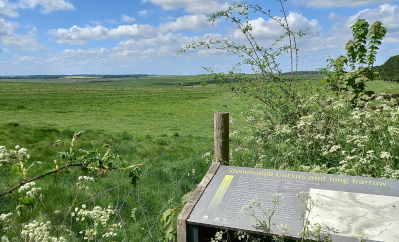
The Stonehenge Cursus, just to the north of Stonehenge is nearly two miles long! Its width is around 400 ft. A cursus is made up of two parallel ditches, joined at the ends in an elongated oval shape; there are around 200 of them spread over Britain.
The Stonehenge Cursus has been dated to between 3630 and 3375 BC, so dates to several hundred years before the earliest stages of construction at Stonehenge.
It was named in the early 1700s by a man named William Stukeley, who imagined it to have been used for chariot racing - due to its shape not unlike the Roman Cursus (or racetrack).
Clearly as it pre-dates the Romans by some 3,500 years this was not the case - as wheels had not been invented at this time! Nevertheless the name stuck, although archaeologists have not yet found an explanation for its use.
Its alignment is east-west (also with nearby Woodhenge); the whole lining up with the midsummer sunrise, although other alignments at the equinoxes have also been noted.
More recently, two pits have been discovered which show that when viewed from the heel stone at Stonehenge, they would have marked the rising and setting positions of the sun the summer solstice.
A gap at the northern end of the Cursus could have been an opening for processions to walk the pathway.
The Avenue
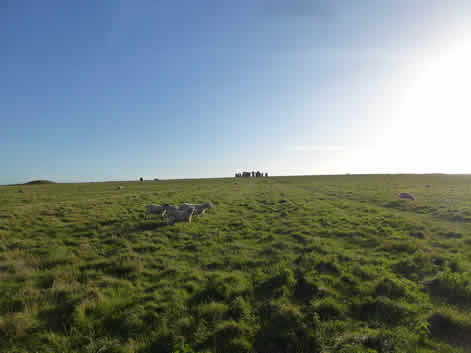
Stonehenge Avenue was discovered in the 18th century. It was thought to have been built during the third stage of building at Stonehenge, and is nearly two miles long, being made up of a pair of parallel banks set about 37 yards apart.
Starting at the River Avon, it runs north west for about 3/4 mile, where it then turns and follows a westerly direction, passing between the two sets of barrows - the New King and the Old King. This is its longest stretch, it then takes a sharp turn south west at 'the elbow', where it heads gently uphill towards the Stone Circle of Stonehenge.
The Avenue is thought to have been built as a processional route towards Stonehenge, but also may have been to commemorate the journey taken by the Bluestones from the River Avon, if this was how they had been transported here.
The Avenue might still give the best possible view of Stonehenge; English Heritage provide a downloadable audio tour which takes you from the Fargo plantation, down the ancient processional avenue and up to Stonehenge.
King Barrow Ridge
Barrows had been created from Neolithic times onwards. Some of the most interesting finds came from the Bronze Age, and around Stonehenge there are some classic examples of at least forty of them. If standing at the stones, if you look due east, along the A303, you can see the King Barrow Ridge. This is an area of three groups of barrows running north-south. Mixed woodland, contains burial mounds of mostly round barrows, standing among ancient beech trees. Striking mounds of grass are easy to see in a line.
Excavation has revealed pits with artefacts such as pottery, flint tools and bones, all pre-dating Stonehenge. There is just one long barrow in this area, from a much earlier period, Neolithic rather than Bronze Age. This dates from between 4000-3000 BC. It is located further north from both the Old and the New King Barrows, at the eastern end of the cursus.
Normanton Down Barrows
Normanton Down is located in the other direction from the King Barrow Ridge, south west from Stonehenge, half a mile away, across the A303. Here many types of barrow ranging from disc to bell shaped to bowl shaped can be seen.
The famous Bush Barrow, excavated in 1808 revealed a male skeleton with a rich array of burial goods including a lozenge shaped sheet of gold, bronze daggers and axe and more. The goods suggest that the people buried here would have carried high status, and would have been leaders in their community.
Excavation controls are now much stricter, with the area being designated part of the World Heritage Site. Like Stonehenge, the Normanton Down barrows would have been used for special, ceremonial occasions rather than every day use.
Winterbourne Stoke Barrows
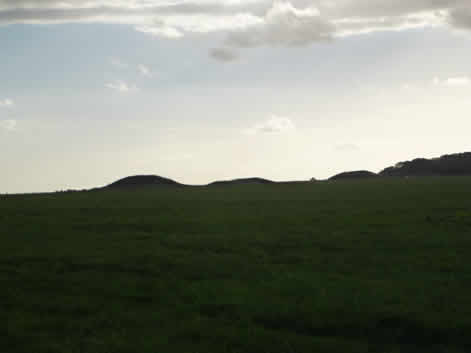
Winterbourne Stoke Barrows are situated one and a half miles west from Stonehenge, just to the right of the A360, the road that goes up to Stonehenge Visitor Centre. Winterbourne Stoke is a very impressive barrow cemetery, containing barrows of almost every conceivable shape including bowl, saucer, disc, bell and pond.
Here a Neolithic long barrow can be seen, as well as some later Bronze Age round barrows. Like other similar monuments, these barrows would have been the final resting places for some of the most important people of these periods.
Archaeological finds turned up include bronze daggers, urns, pottery, flints and amber beads. Most of the barrows were dug in a southwest-northeast alignment.
Robin Hood's Ball
One of the earliest constructions in the area - built up to a thousand years before Stonehenge and the other monuments at 4000 BC - was a place now known as Robin Hood's Ball. In fact this area sits just outside the Stonehenge World Heritage Site, but is listed as an associated site by UNESCO.
Robin Hood's Ball is a 'causewayed enclosure', a series of ditches dug in short segments, with gaps or 'causeways' between them, all leading the to centre of a circle. When Robin Hood's Ball was dug there would have been no surrounding woodland, meaning it would have been a strategic position on a low hill, for viewing the Plain in all directions. It is likely that like Stonehenge, Robin Hood's Ball was built for ceremonial rather than defensive purposes.
At the time of building Neolithic people were undergoing a major transition from hunter-gather to more settled lifestyles with farming. It is one of many causewayed enclosures in the south of the UK, leading to speculation by some scholars that they may have served as gathering places for tribal communities to come together. It is thought that Robin Hood's Ball began to fall out of use around 3000 BC, about the time construction of Stonehenge was beginning.
Woodhenge
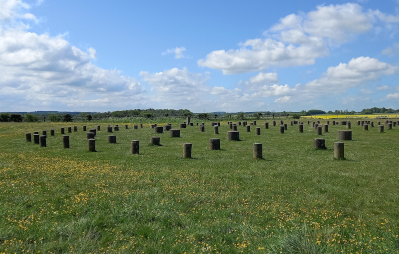
Woodhenge is two miles northeast of Stonehenge. Woodhenge was contemporary with Stonehenge. It has a diameter of around 95 yards, and just one entrance to the north-north east.
What can be seen now are simple colour coded concrete posts, set into six concentric rings, designed to show the visitor where timber posts would have been around 4.5-5,000 years ago. The concrete posts are graduated in size so that the largest of them form the band in the middle, with smaller ones on the inner and outer concentric rings. This led some to believe they could have supported a timber roof, but no further evidence has proved this to be the case.
Towards the centre of the circles you will see a low flint cairn, marking the spot where a young child was found in a pit, buried. Bones from a young adult male were also found in the ditch near the entrance. Various artefacts such as Grooved ware pottery and antler picks as well as flint tools were recovered from the site.
The Cuckoo Stone
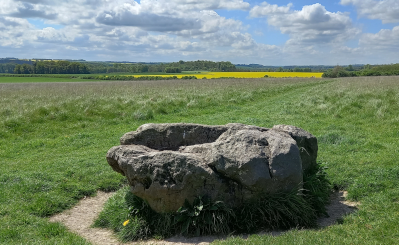
The Cuckoo Stone is a short, rather misshapen sarsen stone that was once a standing stone but now lies on its side. Its location is in the field some 550 yards west of Woodhenge, 1.5 miles northeast of Stonehenge. It is thought that the stone was abandoned sometime during the building of Stonehenge.
Although it is now on its side, it was standing some time during the late eighteenth and early nineteenth centuries when it was written about by Sir Richard Colt Hoare, a local historian. A Cuckoo Stone, or Fool's Stone is a name given to solitary standing stones, often left by melting glaciers.
Durrington Walls
While Stonehenge was a monument for the dead, Durrington Walls was the home of the living, a place of feasts and rituals. Today it can be seen as as a massive grassy ridge, surrounding a central basin. The henge is 1600 ft in diameter, making it the largest in Britain.
Recent archaeology has discovered pits, that contained wooden posts, marking what would have been a giant timber monument, belonging to the builders of Stonehenge. At one time thousands of people - builders of Stonehenge and their families - would have been living at Durrington Walls.
MOST POPULAR TOURS FROM LONDON 2024
VISITING STONEHENGE AND/OR WINDSOR AND/OR BATH
| Stonehenge Morning Half Day Tour - from £65 |
| Windsor Castle Windsor Morning & Afternoon Tours - from £70 |
| Windsor, Bath & Stonehenge (inc Lunch, no adm Roman Baths) - from £99 |
| Windsor, Bath & Stonehenge (no Lunch, inc adm Roman Baths) - from £92 |
| Windsor, Stonehenge & Salisbury - from £85 |
| Windsor & Bath Day Tour - from £85 |
| Windsor, Bath & Stonehenge (Small Group - Max 16 people) - from £156.60 |
| Stonehenge & Bath (Stonehenge admission only) - 3.5 hrs in Bath - from £88 |
| Stonehenge & Bath (Stonehenge & Baths adm) - 3.5 hrs in Bath - from £116 |
| Stonehenge & Bath (Stonehenge & Jane Austen Centre) - 3.5 hrs in Bath - from £118 |
| Stonehenge & Windsor (featuring extended time at Windsor) - from £85 |
| Stonehenge & Avebury - from £114 |
| Windsor, Stonehenge & Oxford - from £79 |
| Stratford, Cotswolds, Bath & Stonehenge - from £128 |
| Stonehenge, Glastonbury & Avebury (Small Group) - from £156.60 |
| Bath, Cotswolds, Stonehenge & Avebury (Small Group) - from £156.60 |
VISITING COTSWOLDS AND/OR OXFORD AND/OR STRATFORD AND/OR WARWICK
| Oxford, Stratford & Warwick Castle - from £74 |
| Oxford, Cotswolds & County pub lunch (Small Group) - from £156.60 |
| Stratford & Cotswolds (inc Anne Hathaway’s) - from £85 |
| Full-day Cotswolds only Tour (Small Group) - from £127 |
| In-depth Cotswolds Only Tour + Lunch - from £127 |
| Blenheim Palace, Downton Abbey Village & Cotswolds Tour - from £72 |
| Stratford, Cotswolds, Bath & Stonehenge - from £128 |
| Windsor, Stonehenge & Oxford - from £79 |
| Oxford & Cambridge Tour (May-Sep only) - from £97 |
| Downton Abbey & Blenheim Palace (Small Group) - £156.60 |
VISITING CANTERBURY, LEEDS CASTLE & DOVER
| Small group Leeds Castle, Dover & Canterbury with river cruise - from £149 |
| Dover Castle, White Cliffs & Canterbury - from £125 |
| Canterbury, Dover & Kent Villages - £139 |
SPECIAL THEME TOURS
| Stonehenge Special Access (Walk Among Stones) Tours |
| Downton Abbey + Highclere Castle Tours |
| Harry Potter Tours |
| London Rock Tour |
DAY TOURS BY TRAIN TO LIVERPOOL, PARIS & SCOTLAND
| Beatles Liverpool Day Tour - £198 |
| Day Trip to Paris - from £259 |
| Day Trip to Edinburgh - from £225 |
2 TO 12 DAY TOURS COVERING GREAT BRITAIN, IRELAND, PARIS & AMSTERDAM
| 2-day Windsor, Stonehenge, Bath & Oxford - from £349 |
| 3-day Stonehenge, Glastonbury, Bath & SW - from £275 |
| 5-day Peak District, Wales & Yorkshire- from £425 |
| 2-day private Stonehenge, Bath, Cotswolds & Oxford - from £650 |
| Budget 3 days in Paris - from £289 (not currently available) |
| Luxury 2 & 3 days in Paris - from £399 (not currently available) |
| 2-day Edinburgh - from £312 |
| 3-day Edinburgh & Scotland Weekend - from £379 (not currently available) |
| 3-day Edinburgh & Scotland Anytime - from £999 |
| 6-12-day tours of Great Britain and Ireland - from £1425 |







